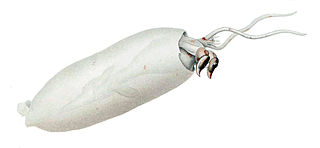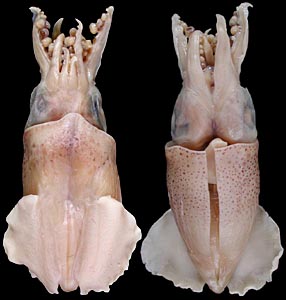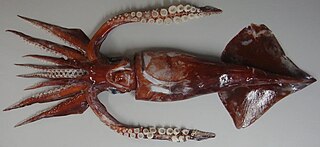
Oegopsida is one of the two orders of squid in the superorder Decapodiformes, in the class Cephalopoda. Together with the Myopsina, it was formerly considered to be a suborder of the order Teuthida, in which case it was known as Oegopsina. This reclassification is due to Oegopsina and Myopsina not being demonstrated to form a clade.

Taoniinae is a subfamily containing ten genera of glass squids.
Liguriella is a genus of glass squids, the genus is probably monotypic, the only species being Liguriella podophthalma. The other named species Liguriella pardus, which was described by S. Stillman Berry in 1916, is cited as a taxon inquirendum but it is suggested that there may be in fact more than one species and there are species yet to be described.
Egea inermis is a species of glass squid in the monotypic genus Egea.

Bathothauma lyromma, the lyre cranch squid, is a highly modified species of glass squid from the family Cranchiidae with a distribution which encompasses most of the world's oceans from the tropics to high latitudes.

Liocranchia is a genus of glass squid from the family Cranchiidae. They are moderate-sized with a long, spindle-shaped mantle which tapers to a point at the rear and they can attain mantle lengths of 250 millimeters (9.8 in). The species in Liocranchia have a cosmopolitan distribution in tropical and subtropical oceans although it has been suggested that on especies, Liocranchia reinhardti is associated with land masses. In seas off Hawaii waters, L. reinhardti undergoes vertical migrations while L. valdiviae occurs in deep water and is sedentary. They are eaten by many oceanic predator species.

Taningia danae, the Dana octopus squid, is a species of squid in the family Octopoteuthidae. It is one of the largest known squid species, reaching a mantle length of 1.7 m (5.6 ft) and total length of 2.3 m (7.5 ft). The largest known specimen, a mature female, weighed 161.4 kg (356 lb).

A. aldrichi is a small species of squid found in northern Australian waters. The species was described by Chung Cheng Lu in 2005 based on specimens collected in the inshore waters of Northern Australia. The largest known individual of this species is a mature female measuring 27.6 mm (1.09 in) in mantle length (ML). The holotype is a mature male of 21.3 mm (0.84 in) ML. A live specimen of A. aldrichi has yet to be recorded. A. aldrichi is a member of the class Cephalopoda and part of the subclass Coleodia. Within this class there are two orders, the Myopsida and Oegopsida, which both fall under the superorder Decapodiformes. A. aldrichi falls under the order of Myospida, and is the only member of its genus, Australiteuthis, and family, Australiteuthidae.

Stoloteuthis leucoptera, also known as the butterfly bobtail squid, is a widespread species of bobtail squid. Its natural range covers the Atlantic Ocean, Mediterranean Sea, and southwestern Indian Ocean. It is distributed from the Gulf of St Lawrence to the Straits of Florida in the western Atlantic and in the Bay of Biscay in the eastern Atlantic. In the Mediterranean Sea, it is specifically found in the northern and southern Tyrrhenian Sea, Ligurian Sea, and off Gorgona Island. S. leucoptera has also been recorded from the Benguela Current off Namibia. There exist unverified records of specimens off eastern Tasmania.

Galiteuthis armata, the armed cranch squid, is a large species of glass squid. It reaches a mantle length of 61 cm (24 in). The species is native to the Atlantic Ocean and has been recorded from Bermuda, Canada, Namibia, and Spain. Armed cranch squids often appear to have bloated bodies, short arms, with thin but muscular mantles. They also contain large buoyancy chambers.

The colossal squid is the largest member of its family Cranchiidae, the cockatoo or glass squids, with its second largest member being Megalocranchia fisheri. It is sometimes called the Antarctic cranch squid or giant squid and is believed to be the largest squid species in terms of mass. It is the only recognized member of the genus Mesonychoteuthis and is known from only a small number of specimens. The species is confirmed to reach a mass of at least 495 kilograms (1,091 lb), though the largest specimens—known only from beaks found in sperm whale stomachs—may perhaps weigh as much as 600–700 kilograms (1,300–1,500 lb), making it the largest known invertebrate. Maximum total length has been estimated at 9–10 metres (30–33 ft). The colossal squid has the largest eyes of any known creature ever to exist, with an estimated diameter of 27 cm (11 in).

The neon flying squid, sometimes called the red flying squid, akaika, and red squid is a species of large flying squid in the family Ommastrephidae. They are found in subtropical and temperate oceanic waters globally.

Teuthowenia megalops, sometimes known as the Atlantic cranch squid, is a species of glass squid from the subarctic and temperate waters of the northern Atlantic Ocean. They are moderately sized squid with a maximum mantle length of 40 cm (16 in). Their very large eyes are the source for the specific name megalops. Like other members of the genus Teuthowenia, they are easily recognizable by the presence of three bioluminescent organs (photophores) on their eyeballs.

Doryteuthis is a genus of squid from the waters of the western Atlantic and eastern Pacific off the coast of the Americas species are the common inshore squids of American waters. Some species are important quarry species for fisheries.

Taonius belone is a glass squid belonging to the genus Taonius from the family Cranchiidae. It occurs in the northern subtropical and in the tropical or equatorial waters of the Pacific Ocean and the Indian Ocean.
Lampadioteuthis megaleia is a small, colorful squid, the only species in the only genus in the monotypic family Lampadioteuthidae. It is sometimes known as the wonderful firefly squid. It was formerly classified in the family Lycoteuthidae, but differs from them mainly by having a hectocotylus in the males and by the possession of a rostrum on the gladius.
Neoteuthis is a monotypic genus of squid, the sole member is Neoteuthis thielei, from the family Neoteuthidae. This species has long tentacular clubs measuring 60% of the mantle length and fins which are 70% of its mantle length. It has a proximal locking-apparatus for the club which is restricted to manus, which in turn has proximal suckers which are circular. It has been recorded from the South Atlantic Ocean, North Atlantic Ocean, near the Canary Islands and North Pacific Ocean, north of Hawaii. The paralarvae and juveniles are found in the epipelagic to mesopelagic zones while adults occur in the mesopelagic to bathypelagic zones.
Nototeuthis is a monotypic genus of squid, in the family Neoteuthidae. The only species in this genus is Nototeuthis dimegacotyle . This species is characterised by short tentacular clubs, less than 40% of the length of the mantle, and relatively long fins, which are approximately 60% of the mantle length. The tentacle clubs have two greatly enlarged suckers on distal portion of the manus, which distinguish N. dimegacotyle from other members of the Neoteuthidae. Few specimens of this species are currently known. Specimens have been collected from the south eastern Pacific Ocean, off Chile, between the Southern Subtropical and the Antarctic Polar frontal zones. This species is mesopelagic to bathypelagic and can be found from near the surface to a depth of ~500m.
Ornithoteuthis is a small genus of squid, with two species, from the family Ommastrephidae, the "flying squids", the two species in this genus are known as "bird squids". They are relatively small squid, with mantle lengths of around 100–200 mm (3.9–7.9 in), highly agile and rather uncommon. Their characteristics that distinguish then from other members of the subfamily Ommastrephinae are that their mantle and fins are drawn out into a narrow tail and that they have a luminous stripe along their midline on the viscera.

Todarodes is a genus of flying squid from the subfamily Todarodinae, of which it is the type genus. The genus contains five species which are partially allopatric but between them their distributions encompass most of the world's oceans and seas. These squid have a funnel groove with foveola, a hectocotylised fourth arm and tentacular stalks which lack free trabeculae.















